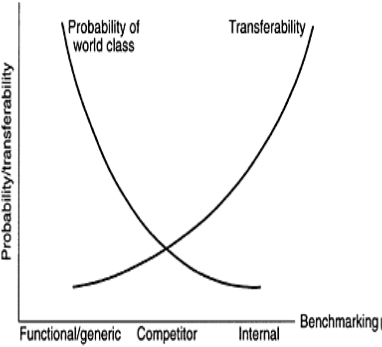SKEDSOFT
WHAT IS BENCHMARKING? (2)
Competitor benchmarking:
By competitor benchmarking the company compares itself directly to present and potential competitors within the same range of products (e.g. competitors at foreign markets) in order to gather information on the competitors’ products, processes and results to be able to compare this information with the company’s own results and to learn from the differences.
Advantages:
- The advantages of competitive benchmarking, beside the fact that the company puts itself in a certain position in comparison with its competitors, is that at a very early stage, the company’s attention is drawn to the expectations which the customers may rightly have from it.
- Furthermore, the results have a high degree of comparability as the products and thus the basic production structures are identical.
Disadvantages:
The disadvantage of this form of benchmarking is that the gathering of data is difficult. In many cases, you have to consult indirect sources as direct information from the competitors is unattainable.
Functional/generic benchmarking:
- In the third type of benchmarking, called functional/generic benchmarking, the potential comparative partner is any company which has obtained a reputation of being excellent within the area which is benchmarked.
- In this case, it means that the company does not necessarily have to limit itself to its own trade but keep its eyes open to ‘best practice’ everywhere.
- If, for instance, you want to study the dispatch of orders, it may be natural to compare with a mail order company or other companies which handle a great number of orders every day. If instead you want to study information systems, it could be a computer company with which you should compare yourself.
Advantages:
- The advantage of this form of benchmarking is that the probability of finding world class practice grows as the number of potential benchmarking partners is expanded.
- On the other hand, it is obvious that the possibility of transferring the found practice directly to one’s own company is smaller than by the other types of benchmarking.
- Another advantage is that the collection of data in this case is considerably easier than by competitive benchmarking as it is much easier to get a co-operation going with companies from other lines of business than your own line.
Conclusion:
- The figure distinguishes on the horizontal axis between three types of benchmarking.
- On the vertical axis is measured the probability of finding world class practice AND the extent of the possibility of direct transfer (that is without adjustment) to one’s own company of the practice found.
- As previously mentioned, it can be seen that usually the procedures found internally can to a large extent be transferred directly.
- On the other hand, the probability of finding world-class practice internally is usually small.
- It is the exact opposite by functional benchmarking. Here the probability of finding world class practice is large.
- On the other hand, it is usually necessary to adjust ‘best practice’ to the conditions of one’s own company. Competitive benchmarking lies in the middle of these two extremes.

Fig: Characteristics of the three types of benchmarking